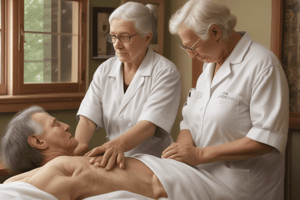Podcast
Questions and Answers
What is one of the primary physiological effects of massage?
What is one of the primary physiological effects of massage?
- Improves digestive function
- Reverses skin aging
- Enhances cognitive functions
- Increases blood circulation (correct)
Which type of massage is specifically designed for athletes?
Which type of massage is specifically designed for athletes?
- Trigger Point Therapy
- Thai Massage
- Sports Massage (correct)
- Deep Tissue Massage
Which massage technique focuses on balancing energy flow in the body?
Which massage technique focuses on balancing energy flow in the body?
- Deep Tissue Massage
- Thai Massage
- Shiatsu (correct)
- Swedish Massage
What is a potential mental benefit of receiving massage therapy?
What is a potential mental benefit of receiving massage therapy?
Which condition is a contraindication for massage therapy?
Which condition is a contraindication for massage therapy?
What type of massage technique involves focusing on specific tight areas within muscle tissue?
What type of massage technique involves focusing on specific tight areas within muscle tissue?
Which of the following is NOT a physical benefit of massage?
Which of the following is NOT a physical benefit of massage?
Why is anatomical understanding essential for massage practitioners?
Why is anatomical understanding essential for massage practitioners?
Flashcards are hidden until you start studying
Study Notes
Overview of Massage Theory
- Definition: Massage theory involves the study of various massage techniques, their physiological effects, and the benefits to the body and mind.
Key Concepts
-
Physiological Effects:
- Increases blood circulation
- Enhances muscle relaxation
- Reduces muscle tension and pain
- Stimulates the lymphatic system
-
Psychological Effects:
- Promotes relaxation and stress relief
- Enhances mental clarity
- Improves mood and emotional well-being
Types of Massage
-
Swedish Massage:
- Focus on relaxation and tension relief.
- Uses long strokes, kneading, and circular movements.
-
Deep Tissue Massage:
- Targets deeper layers of muscle and connective tissues.
- Often used for chronic pain and muscle tension.
-
Sports Massage:
- Specifically designed for athletes.
- Aims to prevent and treat injuries; improves flexibility.
-
Trigger Point Therapy:
- Focuses on specific tight areas within muscle tissue.
- Relieves referred pain and improves muscle function.
-
Shiatsu:
- Japanese technique involving finger pressure on acupuncture points.
- Balances energy flow (Qi) in the body.
-
Thai Massage:
- Combines assisted stretching and acupressure.
- Focuses on energy lines and flexibility.
Theory of Massage Techniques
-
Anatomical Understanding:
- Knowledge of muscle groups and their functions is crucial.
- Awareness of human anatomy enhances technique effectiveness.
-
Energy Flow:
- Many traditional techniques (e.g., Shiatsu) emphasize energy balance.
- Practitioners often consider the body's energy meridians.
Benefits of Massage
-
Physical Benefits:
- Pain relief and improved mobility.
- Faster recovery from muscle injuries.
- Reduced swelling and inflammation.
-
Mental Benefits:
- Alleviation of anxiety and depression.
- Improvement in sleep quality.
- Enhanced overall sense of well-being.
Contraindications
- Conditions where massage may not be appropriate:
- Contagious skin diseases
- Severe bruises or fractures
- Blood clotting disorders
- Certain cardiovascular problems
- Recent surgeries or physical injuries
Conclusion
- Understanding massage theory is essential for practitioners to provide effective treatment, address client needs, and ensure safety during massage therapy.
Massage Theory Overview
- Massage therapy involves understanding techniques, physical effects, and mental benefits.
Physiological effects of massage
- Increases blood circulation: This delivers oxygen and nutrients to muscles, aiding recovery and reducing muscle soreness.
- Enhances muscle relaxation: Smooths out muscle fibers, easing tension and reducing pain.
- Reduces muscle tension and pain: By addressing knots and trigger points, massage helps relieve chronic muscle tension and pain.
- Stimulates the lymphatic system: Helps the body flush out toxins and waste products, leading to a healthier immune system.
Psychological effects of massage
- Promotes relaxation and stress relief: Reduces the body's stress hormone (cortisol) levels, leading to a calming effect.
- Enhances mental clarity: Improves focus and concentration by reducing anxiety and improving blood flow to the brain.
- Improves mood and emotional well-being: Releases endorphins, which have mood-boosting effects and improve overall well-being.
Types of Massage
- Swedish massage: Emphasizes relaxation and tension relief using long strokes, kneading, and circular movements.
- Deep tissue massage: Targets deeper muscle layers and fascia (connective tissue), addressing chronic pain and muscle tension.
- Sports massage: Tailored for athletes, aims to prevent and treat injuries, improve flexibility and athletic performance.
- Trigger point therapy: Focuses on relieving "trigger points" - tight areas within muscles that can cause referred pain in other areas.
- Shiatsu: Japanese technique using finger pressure on acupuncture points to balance energy flow (Qi) in the body.
- Thai massage: Combines assisted stretching and acupressure, focuses on energy lines and improving flexibility.
Massage Technique Theory
- Anatomical understanding: Knowledge of muscle groups and their functions is crucial for effective massage techniques.
- Energy flow: Many traditional techniques, such as Shiatsu, emphasize balancing energy flow in the body. Practitioners consider energy meridians (pathways) within the body.
Benefits of Massage
- Physical benefits: Relief of pain, improved mobility, faster recovery from injuries, reduced swelling and inflammation.
- Mental benefits: Alleviation of anxiety and depression, improvement in sleep quality, enhanced overall sense of well-being.
Contraindications
- Conditions where massage may not be appropriate:
- Contagious skin diseases
- Severe bruises or fractures
- Blood clotting disorders (e.g., deep vein thrombosis)
- Certain cardiovascular problems (e.g., uncontrolled high blood pressure)
- Recent surgeries or physical injuries
Conclusion
- Understanding massage theory is crucial for massage therapists to provide effective treatments, address client needs, and ensure safety during massage therapy.
Studying That Suits You
Use AI to generate personalized quizzes and flashcards to suit your learning preferences.




